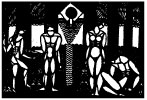Second on the second bill of the 1918-19 season, the first season in the Playhouse at 133 Macdougal Street, was a simpler, straight-forward play by Rita Creighton Smith, entitled The Rescue. Smith had written the play for George Piece Baker’s 47 Workshop at Harvard, of which O’Neill had been an early member. The popular one year course allowed only twelve students from Harvard and twelve from Radcliffe, the men and the women taught separately. The Rescue was given its first production by the Harvard Dramatic Club in April 1916 in connection with the Harvard Summer School. One wonders how or why The Rescue was ever considered by the Provincetown Group for presentation: it was not a new play, there was nothing inherently experimental about it; and Smith was not a member of the organization. The play was published that year in Plays of the Harvard Dramatic Club, edited by Baker, and perhaps the Players became familiar with it through that publication. The play provided a second opportunity for Rauh to both direct and perform the lead role, as she had done with O’Neill’s Where the Cross Is Made. A three-character all-female play, the set described in the stage directions is very specific and quite different from the other two on the bill. Since The Rescue was so much smaller in scope than Moon of the Caribbees, and presented second on the bill, it could potentially have been performed in front of the curtain as the Caribbees set was being changed for the even more elaborate Tickless Time. The stage directions of The Rescue state that the play takes place in “a dignified, gloomy, old-fashioned room with ugly, dark wall paper, hung with family portraits in tarnished frames. One of these, the portrait of an elderly man, hangs above the mantel at the left of the back wall, a branched candlestick before it.”(1) No set designer is listed in the program.
The play concerns Anna, the remaining daughter of the New England house of Warden, who is worried she has inherited her family’s strain of insanity. She has come home for her mother’s funeral, and the only people left in the family home are her aunt, Elvira; the longtime family housekeeper, Kate; and the looming portraits of her dead ancestors on the wall of the living room. She’s been offered a job in New York City, but she feels herself succumbing to something dark that draws her to stay and “become” a Warden, which in her mind includes the possibility of committing suicide as some family members had done before her. Elvira also notices that her bottle of sleeping pills is missing and Anna produces them, though the bottle seems a little emptier than before. Her aunt clearly wants her to stay, despite the possibilities, but Kate gets her alone and begins to encourage her to leave, finally telling her that she isn’t really a Warden, but she alone knew the secret that Anna was born out of wedlock. Without questioning her (for she had been honest with her before about each family member’s history), a relieved Anna decides to depart. Aunt Elvira, eavesdropping in the other room, asks Kate why she had never revealed this fact before, and Kate reveals she lied to give the girl a chance on life. She challenges Elvira to do the same by not contradicting her story. Anna comes in to say goodbye as she goes to catch the last train, and she returns the rest of the sleeping tablets, claiming “I’m not going to need them now.” As she leaves, Elvira worries that Anna is all alone, to which Kate replies “Yes. She’s Alone. (With a glance at the portrait) They ain’t with her” and we hear the outer door close.(2)
Aunt Elvira was played by Helen G. Kittredge, Kate by Ruza Wenclaw, and Anna by Ida Rauh. Kittredge never again performed with the Players, and Wenclaw performed in the third and seventh bills of the season. The New York Herald said the play “proved an interesting psychological drama which gave opportunity for excellent emotional acting by Miss Ida Rauh as Ann Warden.”(3) However, Broun in the New York Tribune thought it a “dull play, although it was in striking distance of an idea.”(4) Perhaps O’Neill thought the idea was interesting as well; many scholars have speculated that the theme of hereditary insanity used in his play Strange Interlude may have been spurred by The Rescue. The gown worn by Rauh in the play was designed by Edith Unger, also known as “Avrile,” who had designed costumes that last year for the Washington Square Players (four productions from 1917-1918) and the Greenwich Village Theatre’s production of Hobohemia.
© Jeff Kennedy, 2007.
(1) Rita Creighton Smith, “The Rescue,” The Provincetown Players, ed. Barbara Ozielbo, (Sheffield, England: Sheffield Academic Press, 1994) 195.
(2) Smith, “The Rescue” 208.
(3) New York Herald, 21 December 1918.
(4) New York Tribune, 23 December 1918, col. 7: 9.
